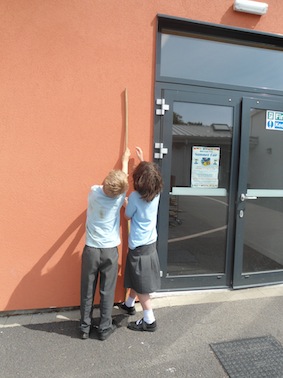
This is a shared blog post between myself and Judy Duncan, a teacher at Greenbrae Primary school who organised a whole session of maths outside for the whole school to participate in, many years ago. Her class were instrumental in the design of the Mud Pi Day logo which was developed from their original ideas.

According to Judy’s plans, the approach is flexible. A number of items will be set up in advance including:
- The tipi – a bit of shelter should it be needed for a quieter, sitting down maths game
- Rope between the trees. There will be pegs nearby for creating number lines. However children will also be free to work on triangles to calculate their perimeters and to investigate the range and size and family likeness of the triangles which can be created from pieces of rope. Tape and poles are also nearby for creating big 3D objects.
- The parachute. This is for numeracy games such as giving each child a number and playing Swap, e.g. Swap places under the parachute if you have an odd number, a factor of 3, a square number, etc.
- Equipment to make big outdoor clock faces for time work: ropes, hoops, sticks for the hands (or the pupils can be the hands)
- Mirror numbers hanging on the fence to find in the correct sequence.
- A giant coordinate grid. This could be used to make human bar graphs or line graphs with pupils carefully standing in spaces or where the ropes cross. Whiteboards can also be added to number the grid.
- Money boxes. There are sixteen numbered boxes of money. Children can work in pairs to find each bag and count the money in each one. Also there are counters for playing the Game of Nim – a strategy game for playing in pairs.
- Using the paved circles to measure circumference, diameter, radius, and for older pupils to investigate the link between the diameter and circumference of a circle. String, meters sticks and rulers are all there.
- Chalk work. An area has been set aside for maths activities which involve using chalk.

Some other outdoor maths ideas
- Use right angle testers and protractors to find a range of angles outside.
- Outdoor algebra. Use chalk to write equations but instead of X and Y use natural objects, e.g. If 3 leaves = 12, what does one leaf represent.
- Venn diagrams with hoops or chalk circles, and a choice of number stones or cards and shapes
How about some Pi…
For outdoor work on Pi, your class could:
- Think of different ways to represent the number 3.14 (and more decimal places) using chalk, natural objects, etc. Your class could see how many digits of Pi they can create with their own bodies.
- Work on measuring the circumference and diameter of circles
- Learn how to draw a circle accurately outside… what would you need to use?
- Measure circles with string and order according to size
- Look for circles in nature – do they exist?

What about Mud Pi?
- Hold a friendly Mud Pie Master Chef competition. Have a range of scales and containers so that children invent mud pie recipes, create their pies and see if they can follow each others recipes. Older children can use the opportunity to practice converting between different standard units.
- Create a Mud Pie Chart…geddit? Data handling at its finest
Use the Twitter hashtags #MudPiDay and #OutdoorMaths to share what you get up to. Alternatively join the Outdoor Maths Facebook page – it’s a growing community of educators keen to explore and share all things maths outside. If you need more outdoor maths ideas, check out all the ones on the Creative STAR website.
This blog post was originally published in March 2018.



















